Build wireless networks without a wireless router
Many people don't know that running Windows XP or Windows Vista can set up a wireless network at home or office without the need for a wireless broadband router or wireless access point, absolutely possible. cost savings. In this tutorial, we will guide you step by step in setting up a wireless network type, known as ad-hoc.
There are more and more people willing to build their own wireless network. Wireless networks can be set up at home or office, from which you can share files, use printers and access the Internet without having to run a network cable jumbled into computers on the network. The best part is that in case you have located computers that are difficult to set up with a wired network cable or in case you want to freely access the network and the Internet with a laptop anywhere inside the document room or house.
Obviously we are talking about laptop computers with wireless networking capabilities - all laptops have this feature. If you're using a desktop or laptop computer without a wireless connection, the first thing to do is buy a wireless network card for every computer you want to connect to the network as well as the Internet.
To set up a separate wireless network, you need to have:
- A broadband Internet connection;
- A wireless network card has been installed on each computer that wants to connect to the network;
- A wireless broadband router (optional).
Usually a hardware component called wireless broadband router or access point is needed. In this tutorial, however, we will show you how to set up a wireless network without resorting to this device, allowing you to save costs. However, you also need to know in advance the disadvantages of not having a wireless router:
- Computers with broadband Internet connections must always turn on. If you turn off this computer, other computers will lose connection to the Internet.
- Your network will be less secure because broadband routers often include hardware firewalls in them.
- The encryption problem used by the usual 'weaker' ad-hoc connection is provided by wireless broadband routers, so it is easily attacked by a hacker (we do not recommend you Use this solution for transferring important data).
- Network speed is limited to less than 11MBps, even if you are using a 54MBps card in your network.
You can also configure an ad-hoc network even if you have a broadband router but don't have wireless capability. In this case, don't forget the second item listed above, but the other items are still true. In addition, it is also important to have a broadband router installed in the network: you need to change the IP address range of the network if it is configured using the 192.168.0.x range. 192.168.1.x because Windows Internet sharing service also uses 192.168.0.x range and then you will have IP address conflicts in your network. This configuration is done by going to the router's installation program (usually opening http://192.168.0.1 from any computer connected to it).
Wireless network card
As we mentioned, you need to buy a wireless network card for every computer you want to connect to the network. These network cards must be compatible with at least one IEEE 802.11 protocol. There are several protocols and the most popular are IEEE 802.11b, 802.11g and 802.11a. The main difference between them is speed: 802.11b protocol can transmit data up to 11MBps, and g and a can transmit up to 54MBps (the difference between g and a is the frequency spectrum they are work). The newly released protocol is n, this protocol will have the largest transfer rate up to 540MBps.
Some network cards have a speed of 108MBps, but in fact 54MBps cards are using data compression techniques and for them to achieve this speed, your broadband router and network card are installed on the computer. This technology is required and must be made from the same factory, otherwise they will not work as regular b, g and a cards. This technology also does not work in ad-hoc networks, meaning that networks do not use broadband routers.
The best scenario is that all computers must use 54MBps (or 108MBps) cards. However, you will be limited by the speed of your network connection. So you don't use your network for file transfers between computers, buying a 54MBps card is not wise, simply because your Internet connection speed will be much lower. For example, if you have a 1MBps connection, there will be a network capable of transferring data 54 times faster than an Internet connection. An 11MBps network will work better for you in this case (it will be about 11 times faster for Internet connection). So you can reduce costs by buying 11MB cards - they work better with average users. Also, ad-hoc networks are simply not expensive. If you really want a 54MBps (or 108Mbps) connection, design a wireless network that uses a router.
A little analysis makes it easy to understand, if you have a 1MBps or 2MBps Internet connection, you still have to stop at that speed even if you use a wireless card of 11MBps or 54MBps.
Even if even after what we said you still decided to buy a 54MBps wireless network card, make sure that the network card is compatible with 802.11b, so you can build a network. Wireless without using a router, because ad-hoc networks only work at 11MBps. It is also a good idea to buy all cards that have the same 54MBps (a or g) standard, in case you decide in the future to upgrade your network by installing a wireless router then all of these cards are can meet the transmission capacity of 54MBps.
There are two types of wireless network cards available on the market: USB and add-on. Usually add-on cards run more stable. The add-on card for desktop computers is provided for PCI slot (possibly for PCI Express x1 slot in the future) and the add-on cards for laptops are provided for PC Card slot (PCMCIA) or Express slot Card. If your laptop does not have a wireless network card included, you need to check if it has an expansion slot (PC Card or Express Card) and buy a wireless add-on card for it (PC Card may be A wise choice because the Express Card slots also accept these devices.
In Figure 1 you can see a wireless PCI card add-on for desktop computers, in Figure 2 is a USB wireless network card that can be used for desktop and laptop computers, and in Figure 3 is a card PC wireless network Add-on card for laptop computers.
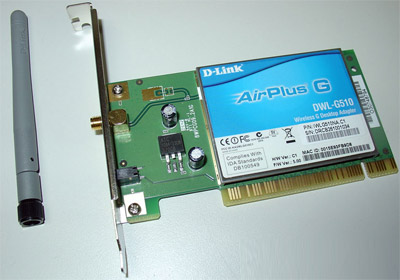
Figure 1: Wireless PCI add-on card
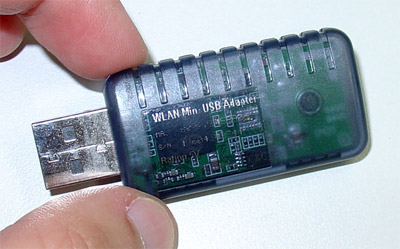
Figure 2: USB wireless network card
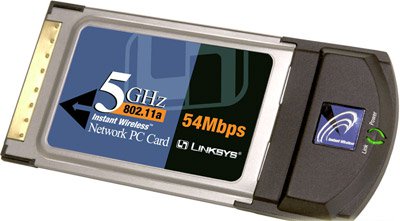
Figure 3: PC Card wireless network card
Installing this card needs to be done according to the card's instruction manual. Usually it is very simple: just connect the device to the computer (if you install a PCI card on the desktop, you need to turn off the device and open the case), turn it back on and install the card driver.
With PCI card as shown in Figure 1 (a D-Link DWL-G510 card), we need to install the driver before installing the card to the computer.
Installing the wireless network card to the computers will be connected to the wireless network. The next step is to configure the server, which means that the computer has a broadband connection. If you want to share your Internet connection with a regular broadband router (ie without wireless capability), any computer that is connected to the router can be configured as a server. In this case you just need to remember: you need to change the IP address range of the network if it is configured to use the 192.168.0.x range to 192.168.1.x because Windows Internet sharing service uses the strip 192.168.0.x and then you will be conflicting with the IP addresses in your network. This configuration is done by going to the router's installation program (usually opening http://192.168.0.1 from any computer connected to it).
Server configuration
You need to configure the server, which means that the computer has a broadband connection. As we mentioned, if you turn off the server, all computers will lose access to the Internet.
Follow the wall instructions below:
1. Go to Start > Control Panel > Network Connections . Right-click the wireless connection (usually called ' Wireless Network Connection ') and select Properties .
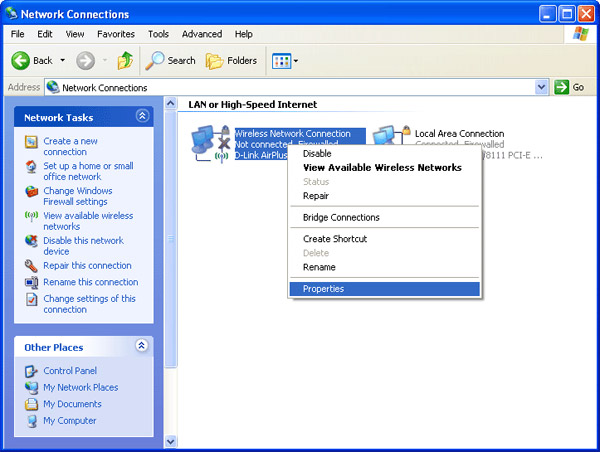
Figure 4: Select the properties of the wireless connection
2. In the window that appears, click on the Wireless Networks tab (see Figure 5). Ensure that no wireless networks are listed under Preferred Networks . If you see any networks here, please delete them one by one.
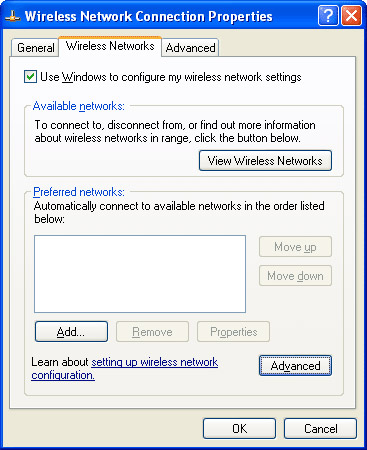
Figure 5: Configure wireless network
3. Click the Advanced button and the window shown in Figure 6 will appear. Select ' Computer-to-computer (ad-hoc) networks only ' and click Close .
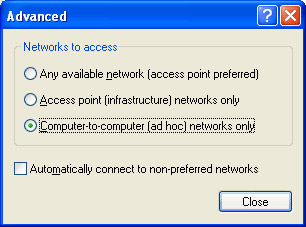
Figure 6: Ad-hoc network configuration
4. The window shown in Figure 5 will show up again. Now click on Add and the new window will appear as shown in Figure 7. You need to fill in some things below:
- Network Name (SSID) : This will be your network name. This is how computers will call the network. In this case, we call it 'MyHome'.
- Network Authentication : Open.
- Data encryption : WEP.
- Uncheck ' The key is provided for me automatically '
- Configuration of security lock . This is the password that will be used to encrypt the transmission data in the network, preventing neighbors from surfing the 'pagoda' and also preventing others from viewing or deleting your files, if file sharing is enabled. in the network.
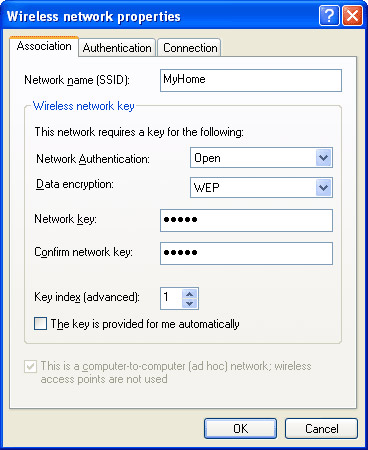
Figure 7: Create your own wireless network
5. After clicking OK , you will see the newly created network appear under Preferred Networks , see Figure 8. The network is still listed with a red 'x', which is very normal and you are not much worry.
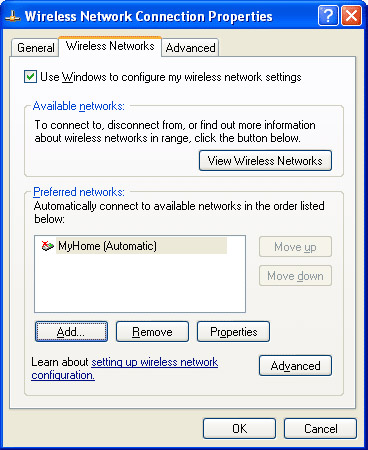
Figure 8: The network is listed
6. Now you need to share the Internet connection. Please note that this is done on a network card with a broadband Internet connected, not a wireless network card. Go to Network Connections ( Start > Control Panel ), right-click the network card that is connecting to the broadband Internet and then select Properties . In the Properties window, click the Advanced tab. On this tab, check the ' Allow other network users to connect thru this computer's Internet connection ' box and uncheck the box ' Allow other network users to control or disable the shared Internet connection ', as shown in Figure 9.
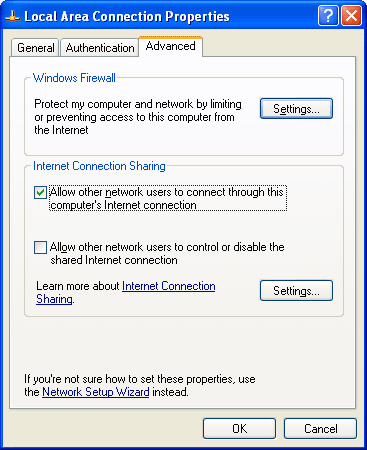
Figure 9: Internet connection sharing
7. Click OK and now you will see the word ' Shared ' under the name of the broadband Internet connection (often called ' Local Area Connection '), see Figure 10. Your wireless connection will there is still the word ' Not Connected '; No problem at all. It will only change to ' Connected ' after a certain computer has entered the network.
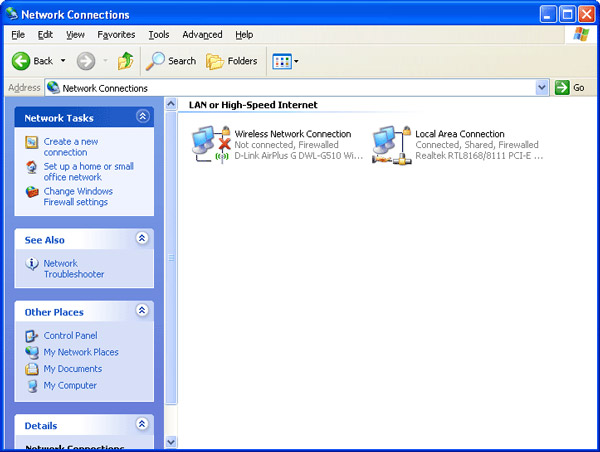
Figure 10: Internet connection has been shared
8. Now that the server is configured correctly, you need to configure other computers to access the wireless network.
Configure other computers
Once you've configured the server, it's time to configure other computers that need to access the wireless network. This configuration is very simple; You just need to follow the steps below:
9. If you have configured the server correctly, the wireless network will be listed in the network list of all computers that have a wireless network card within the range of the card installed on the server. Just click on the wireless network icon on the task bar and double-click your wireless connection in Network Connections ( Start > Control Panel ) to see the list of available wireless networks. As you can see in Figure 11, we have some wireless networks (all of which are our neighbors, so the coding problem here is very important). All you need to do is click on your network (in this case, for example, MyHome ).
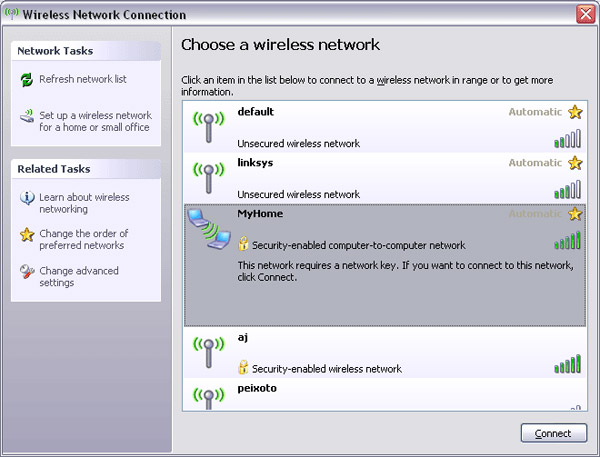
Figure 11: List of wireless networks
10. After double-clicking on your network, Windows will ask for the network password (the password we configured in step 4), see Figure 12:
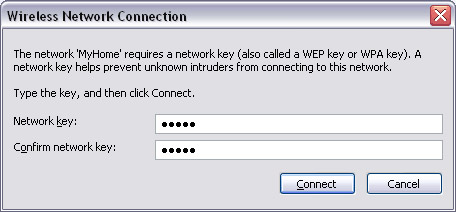
Figure 12: Enter the password key (password) to access the wireless network
11. After clicking OK , the network status will be listed ' Acquiring Network Address ' and then changed to ' Connected ', you can see in Figure 13.

Figure 13: Now you are connected to the network
12. Here you can access the Internet using the Internet connection available in the server. Check the network by opening the web browser (Internet Explorer or Firefox) and entering that web address you know.
13. At this time, the wireless connection server will appear with the words 'connected', as shown in Figure 14. As we said earlier, the wireless connection on the server will appear 'connected' only. when another computer is connected to the network.

Figure 14: The host computer's wireless connection appears ' Connected '.
14. To prevent wireless network problems, we recommend that you delete all other networks that appear in the Preferred Networks list on all computers. You can do so by right-clicking on the wireless connection in Network Connections ( Start > Control Panel ), selecting Properties , when the Properties window appears, click the Wireless Networks tab. Delete all other networks listed in Preferred Networks except for your network, see Figure 15.
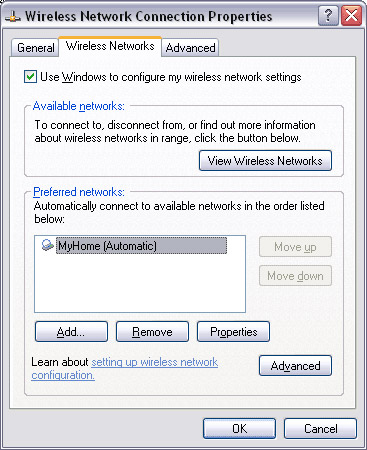
Figure 15: Delete all other networks and leave only your own network
15. You can now share your Internet connection between computers and also configure your network to share printers and files. The best thing about sharing is that the files and printers you want to share do not need to be located on the server, they can be placed on any computer on the network (but if you share a printer then We recommend that you connect the printer to the server because this computer will always be turned on.
You should read it
- Install laptop to prioritize wired network connection
- How to turn on / off automatically wireless network connection in Windows 10
- Set up Ad Hoc wireless network to play WiFi without software from your laptop
- Upgrade wireless network system
- The way that 5G will change Internet connection in your home
- Wireless LAN security (Term 2)
- Several ways to improve Wi-Fi connection
- How strong is the wireless signal in your Wi-Fi network?
May be interested
- Why need to change the wireless channel of the router?
 the 2.4 and 5ghz wi-fi signal range is divided into a number of smaller strips called wireless channels. each wireless channel translates to a specific radio frequency
the 2.4 and 5ghz wi-fi signal range is divided into a number of smaller strips called wireless channels. each wireless channel translates to a specific radio frequency - Use 802.11n for the fastest wireless network speed and maximum coverage
 in many companies, wireless networks are used to serve many different purposes: for corporate visitors, multimedia traffic from marketing departments to conference rooms and access even in corporate cafes. .
in many companies, wireless networks are used to serve many different purposes: for corporate visitors, multimedia traffic from marketing departments to conference rooms and access even in corporate cafes. . - How to set up WEP, WPA, WPA2 for Linksys router
 wireless connection is a necessity today and because of that, wireless security is essential to ensure safety in your local network.
wireless connection is a necessity today and because of that, wireless security is essential to ensure safety in your local network. - 5 tips to help make optimal use of Tomato on the Router
 in the following article, we will show you the 5 most useful tips for tomato, which help speed up your router and your work is done faster.
in the following article, we will show you the 5 most useful tips for tomato, which help speed up your router and your work is done faster. - Top 5 best Xiaomi WiFi routers
 wireless routers are being used in almost every corner of the world today. the best wireless router will ensure your network connections are strong and reliable.
wireless routers are being used in almost every corner of the world today. the best wireless router will ensure your network connections are strong and reliable. - 3 best wireless routers 2021
 whether you want the fastest and most powerful wifi router, feature set that focuses on gaming or wifi speeds just right and won't leave you out of pocket, there's always a wireless router option for you. it is important to know what to look for.
whether you want the fastest and most powerful wifi router, feature set that focuses on gaming or wifi speeds just right and won't leave you out of pocket, there's always a wireless router option for you. it is important to know what to look for. - Create a virtual wireless Router with Windows
 in this tutorial we will show you how to create a virtual wireless router in windows to share internet connection and file sharing.
in this tutorial we will show you how to create a virtual wireless router in windows to share internet connection and file sharing. - Review Tenda N301: The router is compact and affordable
 the tenda n301 router was released in 2013. tenda n301 is equipped with broadcom bcm5357c0 300 mhz chipset, 16mb ram and 2mb flash memory. tenda n301 wifi router is compatible with ieee 802.11b / g / n standards.
the tenda n301 router was released in 2013. tenda n301 is equipped with broadcom bcm5357c0 300 mhz chipset, 16mb ram and 2mb flash memory. tenda n301 wifi router is compatible with ieee 802.11b / g / n standards. - How to Set up a Wireless Network in Windows XP
 this is a walkthrough of setting up wireless (ieee 802.11 also known as wifi) home networking with windows xp. note that if buying a router, all routers are compatible with windows xp. it is wireless adapters that have varying levels of...
this is a walkthrough of setting up wireless (ieee 802.11 also known as wifi) home networking with windows xp. note that if buying a router, all routers are compatible with windows xp. it is wireless adapters that have varying levels of... - How to Connect HP Deskjet 3050 to a Wireless Router
 after connecting your hp deskjet 3050 printer to your wireless router, you can conveniently print documents without worrying about cables. just know the router username and password, you will easily connect your hp deskjet printer to the wireless router on any windows or mac computer.
after connecting your hp deskjet 3050 printer to your wireless router, you can conveniently print documents without worrying about cables. just know the router username and password, you will easily connect your hp deskjet printer to the wireless router on any windows or mac computer.










 Design a small network with a broadband router (Last part)
Design a small network with a broadband router (Last part) Building a wireless network with a broadband router - Part 2: Configuring the router and computers on the network
Building a wireless network with a broadband router - Part 2: Configuring the router and computers on the network Build wireless networks with a broadband router - Part 3: Connect wireless computers to the network
Build wireless networks with a broadband router - Part 3: Connect wireless computers to the network Some experience installing ADSL
Some experience installing ADSL Connect two computers with a USB cable
Connect two computers with a USB cable Create P2P programs on the network using a broadband router
Create P2P programs on the network using a broadband router